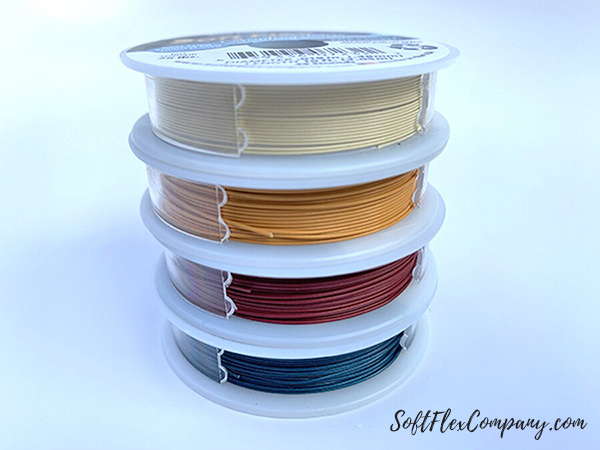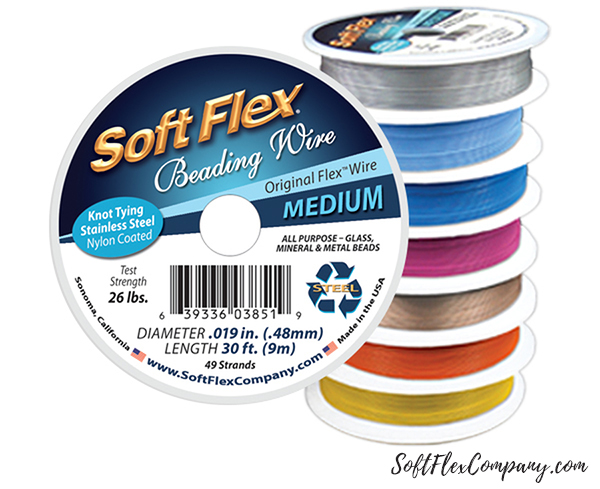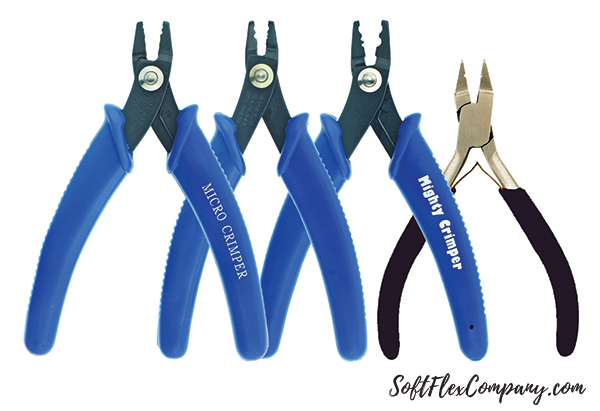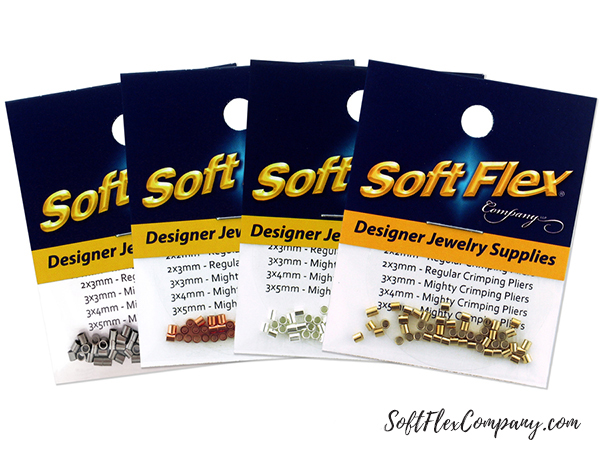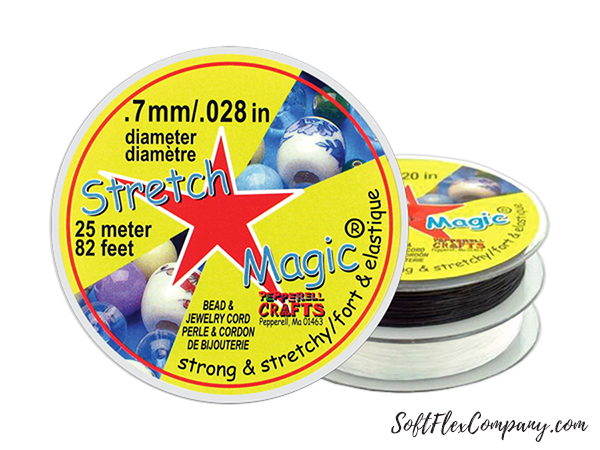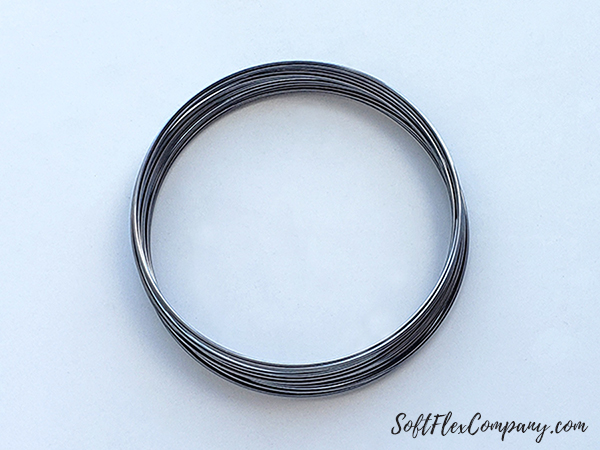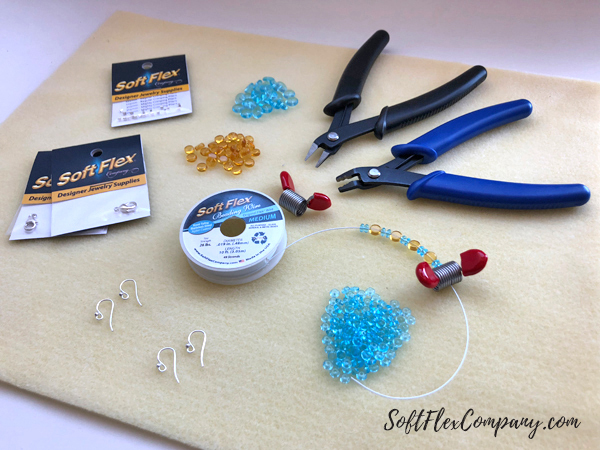Bead stringing can be incredibly confusing to a jewelry making beginner. There are so many variables in what seems like such a simple craft. If you are a beginner, you probably have a lot of questions. Everybody has to start somewhere. Don't worry, it is a lot easier than it looks. We did a little research and found some real questions that you have asked on Amazon and other sites. We have the answers you are looking for!
If you are a beginner, you are probably wondering if thread or fishing line is as good as beading wire. You are probably wondering how to finish your beaded jewelry designs. You may wonder what 'strands' on a beading wire label is referring to. Let's answer some of your most asked questions.
Soft Flex Beading Wire is:
- Hypoallergenic
- Made out of multiple strands of stainless steel covered with nylon
- One of the most flexible and knottable jewelry wires available
- It is the most durable and strongest beading wire available
- Easy to thread without using a needle
- Suited to any stringing project as it drapes well and is kink-resistant
- Ideal for jewelry worn in and out of fresh or salt water
- Available in a wide range of options to suit different crafting projects
10 Questions Beginners Ask About Jewelry Making
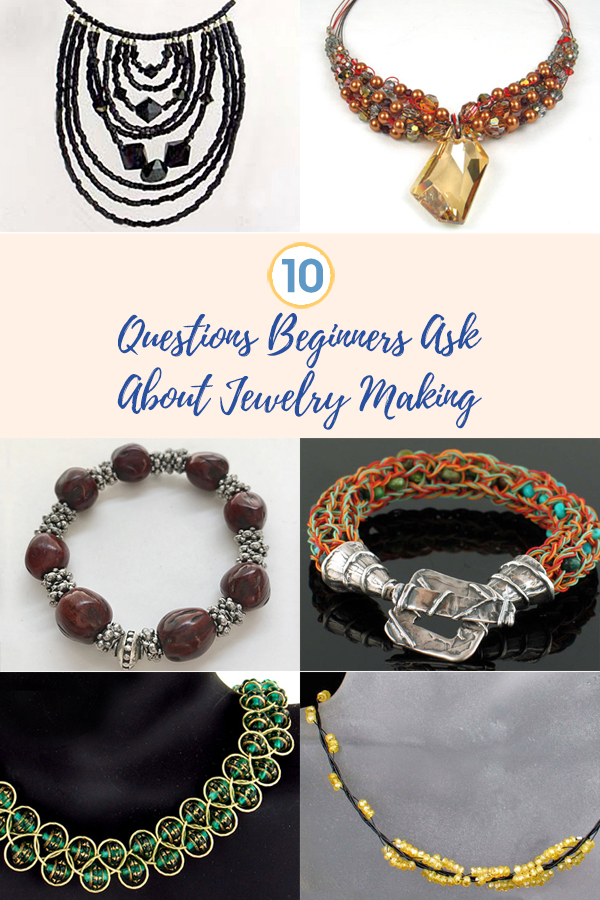
What is Soft Flex Beading Wire?
Soft Flex Wire is the designer's choice in bead stringing wire.
Soft Flex Wire is a lead-free beading wire for designers that demand strength and durability. Soft Flex Wire is a superior beading wire, created by beaders for beaders. Soft Flex Wire is constructed of either 21 or 49 micro woven stainless steel wires. It is supple enough that it can be knotted and comes in a wide variety of colors. It is available in 3 diameters: .014, .019, and .024. We recommend Soft Flex Beading Wire for designers that want their pieces to last and eliminate the frustration of restringing.
Soft Flex Beading Wire got its start almost thirty years ago. Owner Mike Sherman was a passionate jewelry designer. He loved to restring antique pieces and give them an updated polish. His materials and designs were gallery quality and he made a good living selling his distinctive pieces to local shops. Unfortunately, despite having high end tools and supplies, he often found that the stringing materials on the market were not always adequate. Mike tried fishing line and monofilament, they were common but not reliable. His designs would either break or not drape properly.
Mike invented Soft Flex Beading Wire with help from his partner Scott Clark. This marine quality stainless steel beading wire was not afraid of heavy beads and chunky stones. It offered strength, durability, and a drape that was thread-like - the strength of steel and the grace of silk. Mike realized that jewelry designers around the world could benefit from this amazing product.
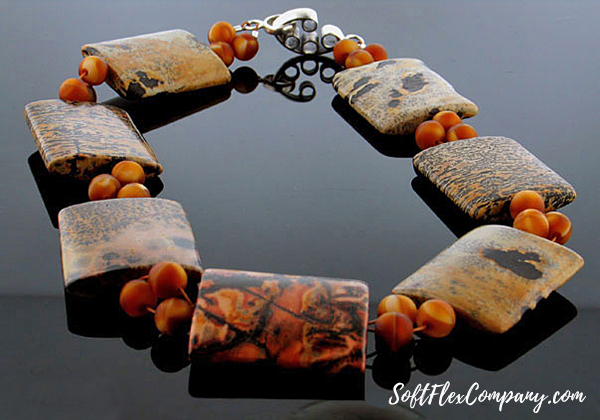
Soft Flex Beading Wire is the best beading wire for so many different design choices. Do you like to design single strand necklaces and conceal the beading wire? We have a satin silver beading wire that is wonderfully neutral. It almost seems to disappear on your design. It is perfect for people that want to hide their wire. This color choice is available in all four of our wire diameters.
"I have personally been using your beading wire for my own projects since early 2001, and I can say without a doubt that Soft Flex beading wire is far superior to all new comers!" - Charlie
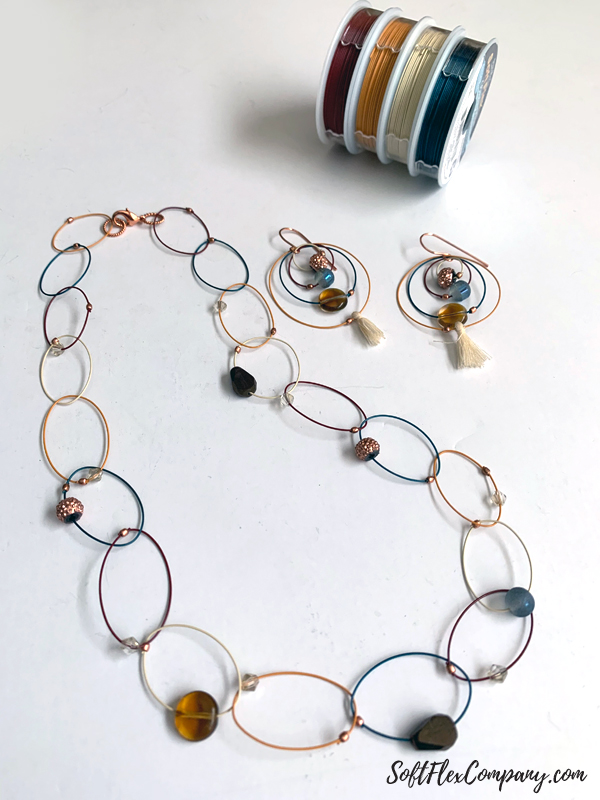
Do you love color? We have a rainbow of options. Our dynamic color choices are perfect for making a statement with your beading wire. Color can accentuate your beads – Rose Quartz looks stunning with our Pink Rhodochrosite beading wire inside, it radiates color! Color beading wire can be exposed on a design, it is perfect for illusion jewelry. It is perfect for any design where you plan to show your wire – Show Your Colors!
Do you love fashion? You will find our color choices are fantastic matches for seasonal Pantone collections. We have a Classic Blue beading wire color, Dark Blue Lapis, that is a perfect fit for Pantone's Color of the Year 2020. Stay on point with our selections. Design jewelry that is cutting edge current or eternally timeless.
Soft Flex Beading Wire color options are also wonderful for sculpting your wire in a design. Do you want to design amazing linked pieces of wire? You can create loops or chain with your wire. It is the perfect choice for macrame or kumihimo. You can weave, stitch or embellish with our wire. Your creativity is the only limit. Explore beading wire and make jewelry that elevates the industry!
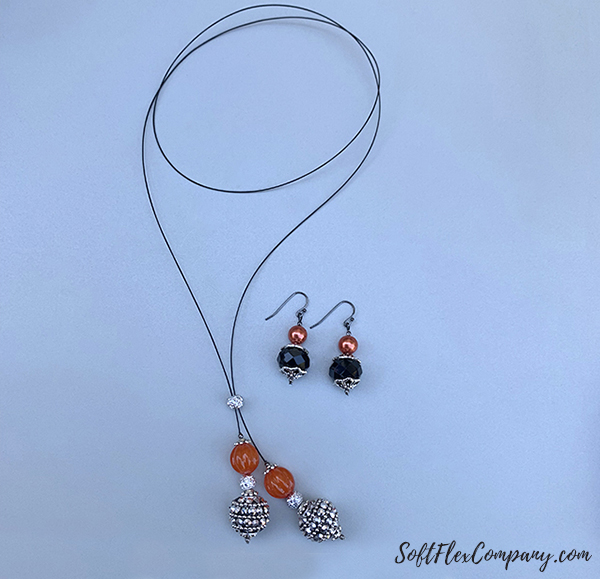
Does it feel and hang like string when worn?
Soft Flex Beading Wire comes in so many options. Drape is one of them. If you like a bold wire-like look to your jewelry, you will love our Original Soft Flex line. The drape is firm and fantastic. It is the most commonly used brands of our wire. If you want a silk like drape, you need to try our Soft Touch Beading Wire. Soft Touch is incredible. It has the same strength and durability our Soft Flex line has – but, it is about 50% softer and more flexible than Soft Flex – in its drape. Soft Touch cascades down the neck or wrist like liquid. You would swear it is silk. Soft Touch is basically the stainless steel version of thread.
Which size and strength of beading wire should I use?
Nobody want to restring a jewelry design. Let's learn a little bit about diameters and sizes. One critical factor when stringing beads is the abrasion level your beading wire can withstand before it becomes ineffective. It helps to know what a diameter's strengths and weaknesses are before you even string the first bead.
What is the best beading diameter wire
for the job? A great rule of thumb is to use the largest wire that
will fit through your beads once. This will ensure your entire
jewelry design is strong. So, if you have chunky beads with very
large holes, go with the largest diameter. If you have black diamonds
with very tiny channels and you cannot seem to fit them on even a
small diameter, check out our Very Fine diameter. Very Fine was
designed for weaving and stitching. It is like a steel thread. It is
perfect for those tiny beads that just refuse to be strung.
But wait! Your best friend has told you that you need to double back through the last beads with your beading wire – for extra security. Well. This was probably a good idea before the beading supplies were improved. Older wire and crimps may have failed often and benefited from this tactic. But, nowadays, we have materials and jewelry supplies that are strong and pass muster. If you use a wire that is small enough to double back through your beads, you are comprising the entire jewelry design for a little perceived extra security at the crimp. As long as you know how to crimp your design, cutting the wire at the crimp is perfect.
Here is a guide for basic wire usage:
.010 Very Fine - Ideal for embellishing, weaving, crocheting and stringing very small beads. We suggest finishing with 1x1mm crimps.
.014 Fine - Ideal for soft materials, seed beads and fresh water pearls. We suggest finishing with 2x2mm crimps.
.019 Medium - Ideal all purpose wire. Great with glass, mineral, and metal beads. We suggest finishing with 2x2mm crimps.
.024 Heavy - Ideal for abrasive materials, large stones, lamp work and bracelets. We suggest finishing with 2x3mm crimps.
Size is a good rule of thumb. Diameters are a good indication of the abrasion level that the wire can tolerate. Go with the largest wire you can through your bead channels and go with a diameter that matches the abrasiveness of your beads or gemstones.
Basically, Very Fine is your best beading wire option for black diamonds and very tiny beads. It is like a beading thread. It is great for weaving, stitching and embellishing. If you can use a larger diameter in your beads, we would suggest moving up. Fine is fantastic for soft beads like pearls and seed beads. It is great for the delicate stuff. Medium is your best beading wire option for everything. Make sure you have lots of this in your beading toolkit. Medium is large enough to endure the most aggressive beaders and small enough to fit through everything. Medium is our workhouse, make it your default wire choice and your designs will never break. Heavy is our beast. This beading wire diameter can withstand the most coarse and abrasive glass, coral, Turquoise, and metal. This should be your choice when you need that extra security.
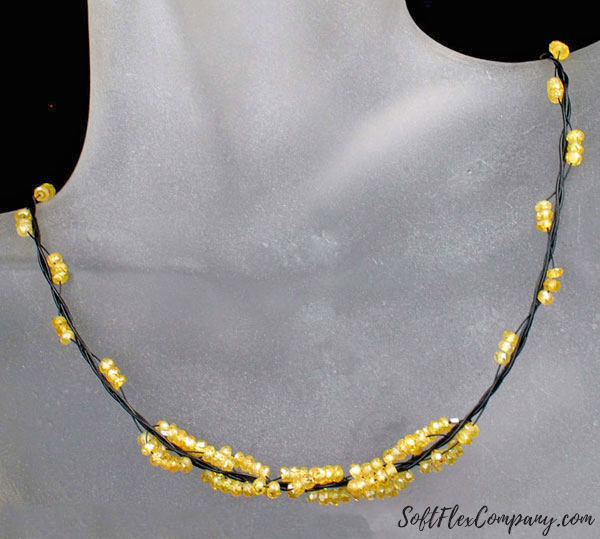
How much weight can it support?
Soft Flex Beading Wire is designed to withstand sharp tugs and snaps. Our wire is measured by its tensile strength. This means you can see how durable our wire is when it comes to a sudden burst or strength. This is not an indication of the weight the wire can bear when worn. Our Heavy diameter can take a savage 40 pound snap before giving way. We don't suggest wearing a 40 pound necklace, though – because, ouch!
Soft Flex Beading Wire - Test Strength
- .010 Very Fine - 5 lbs.
- .014 Fine - 10 lbs.
- .019 Medium - 26 lbs.
- .024 Heavy - 40 lbs.
How do you secure a beading wire?
What is the best way for this thread to be finished with a clasp on a necklace?
For the most secure and professional finish, we suggest you finish your Soft Flex jewelry designs with crimps and a clasp. All of our wire diameters are knottable, but a crimp is going to be a much more durable and aesthetically pleasing finish.
Choosing a crimp size:
For best results, you'll find it best to follow the beading wire manufacturer's guidelines on crimp sizes. Soft Flex Company helps you out by offering a chart of what we call the "most typical" crimp tube and beading wire size combinations:
Soft Flex Beading Wire - Crimp Tube Size
- .010 Very Fine - 1x1mm
- .014 Fine - 2x2mm
- .019 Medium - 2x2mm
- .024 Heavy - 2x3mm
"I just wanted to say that I just received my sample of Soft Flex wires and I'm so excited about this product. I've tried using wires for different products but have always had some difficulty with bends and kinking. This wire is awesome. I don't know what to make first, something for me or something for someone else. Thanks for a great product and I will be back to the website. It's very informative and I enjoy the projects that you have. Thank you." - Rhonda
If you are looking for the best crimps on the market, look no further. We have lots of color options. Our crimps are as colorful as our wire. We carry Sterling Silver Black Oxidized, Sterling Silver, Gold Filled, and Copper. Our crimps are the perfect finish for every design.
Soft Flex Crimp Tubes are crafted with the professional in mind. We have constructed a crimp tube that is almost twice as thick as others on the market. The sturdier build of the crimp is enhanced by the fact that they are also seamless. Finish your next piece securely with our designer crimps.
What is the strongest thread?
We are a little biased, of course. But we strongly suggest high quality beading wire when stringing jewelry designs you want to last. If you cut corners here, you are going to be dealing with a lot of restrung jewelry or customer returns (if you are a jewelry designer). Design with the highest quality materials and you will not have to worry about replacing everything. You will save money in the long run.
Other options are fine if your design calls for a different beading string. Silk is perfect for traditional pearl necklaces. Soft Flex is fine for pearl necklaces, but the knots will not have the same look as silk. Thread is fantastic if you are doing a kumihimo design. Fishing line might be wonderful if you really want an invisible line. But all of these options are less than ideal if you want jewelry that can take the hardest tugs and pulls. These options can also get brittle and weak with age.
Soft Flex is a marine quality stainless steel beading wire. It is going to take a tornado to unravel our stout wire!
What is the best beading wire?
“Your wire is the BEST! It is strong, flexible and easy to work with. Your crimps are wonderful. Each and every one of my crimps is turning out perfect! I am convinced that this is the best out there and I will use it exclusively.” - Vera
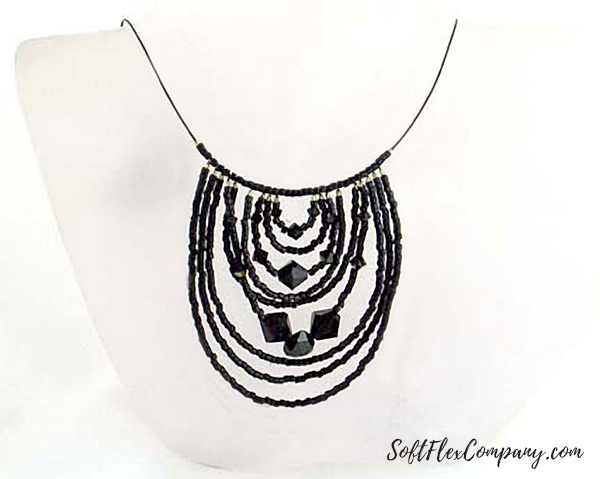
We have always believed that you should let the wire do the talking. You can listen to a pitch. You can hear the positives and negatives. But, the one thing that is going to determine if a wire is a good fit is to actually have it in your hand. You will know you have the right wire when you can play with it and feels its drape. Let the wire talk to you.
How do you go about getting your hands on wire, then? You have a couple of options.
Bead shows are dense with vendors from all around the world. You can touch and feel their merchandise: beads, gemstones, tools, and beading wire. It is a great option for getting a real idea what is out there.
Local bead stores are right in your backyard and full of goodies. You can touch and feel all of their hanks of beads. Occasionally you will find demo spools of the wire they sell. Make sure you support your local bead store, they are a wonderful place to meet new friends and network with design ideas.
Hobby stores will sometimes have a craft section where you can find jewelry supplies. Unless they are jewelry-centric, this might be a smaller area – but you could get lucky. You might even find a store that has demonstrations.
Contact the beading wire companies themselves. This is a great way to really feel and test a specific beading wire. If you would like to get a sample, contact the company and request one. You can request a beading wire sample from Soft Flex Company by emailing Info@SoftFlexCompany.com. We would love to send you a sample!
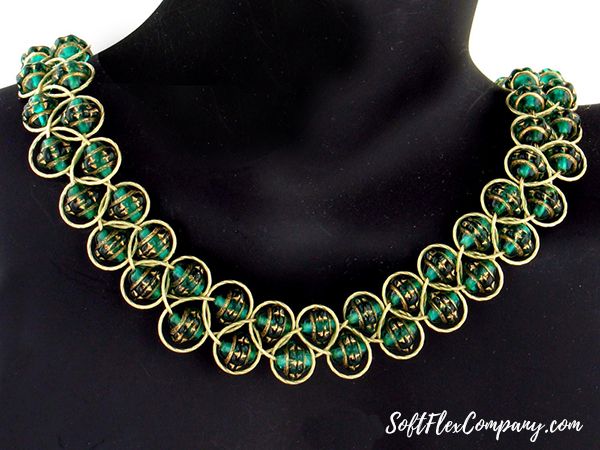
"I personally have used at least 5 different brands of beading wire myself and have found when the smoke has cleared that there are differences in the various brands and that none of them have the quality nor the reliability of Soft Flex or Soft Touch Wire." - Jelcy / Jewelry Artist
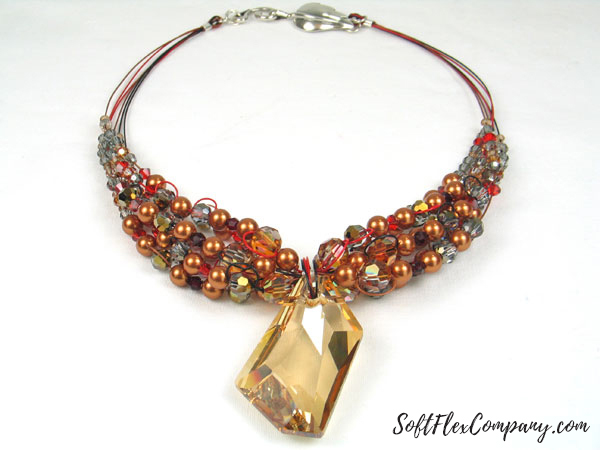
What is the best string to use for bracelets?
Bracelets are really rough on beading thread, string or wire. Bracelets rock back and forth on the wrist throughout the day. Any beads on the bracelet dig and tear into the wire. If you do not have enough room between your beads and crimps, your design is going to be taut and even more rough on the wire. If you like chunkier or abrasive stone, like Turquoise, you are going to need a tough wire for the job.
At Soft Flex Company, we suggest you use our Heavy diameter for bracelets. This is especially true if you plan to use chunky stone or abrasive beads like metal or glass. Our .024 Heavy diameter is ready for the task and torture of a bracelet.
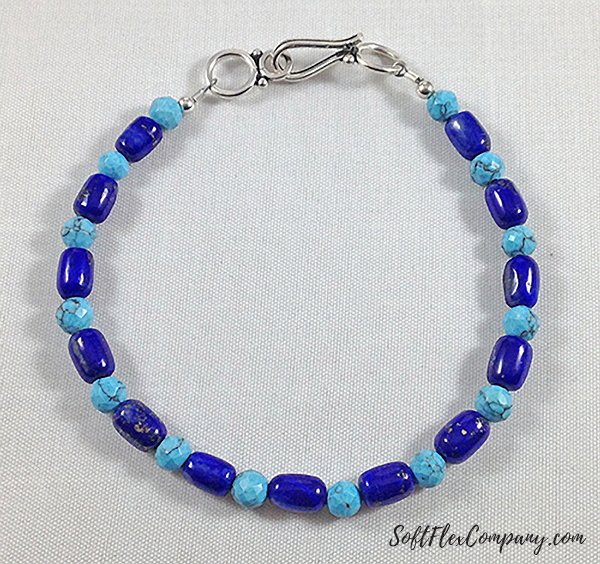
There are always exceptions, however. If Heavy does not fit through your beads, as mentioned above, a good rule of thumb is to use the largest wire that will fit through your beads once. If Medium is the largest wire that will fit – that is the perfect choice for your design. Medium is also great for designs that are more intricate. Knitted or braided designs are wonderful on Medium, our most colorful wire. Knitted designs are also forgiving as the wire can expand and contract without harming the design.
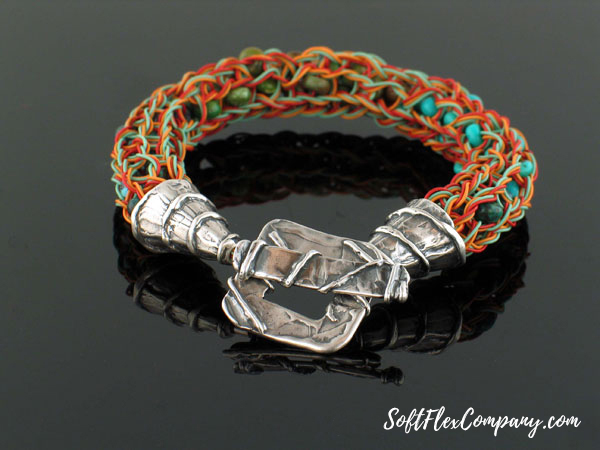
Another option is to use stretchy cord. We carry Stretch Magic. Stretch Magic is a strong elastic-like beading and jewelry making cord. It is made of a unique proprietary polyurethane. It is constructed of a mixture of polyester and polyurethane. Stretch Magic is solid and will not fray over time. It does not contain any latex, rayon, or elastic. It is recommended that you pre-stretch Stretch Magic before beginning a project. This will ensure the cord does not stretch and lengthen after beads are placed on it.
Stretchy cord is fantastic option for bead stringing beginners. It is forgiving and easy to string. This stretchy beading cord is durable and can take the abuse that a bracelet gets as it rocks back and forth on the wrist. It will last a long time. All a beginner needs to start out with stretchy cord is some beads, scissors or a bead nipper, and some glue and they have everything necessary for a jewelry design.
Shop our Stretch Magic cord. This elastic like cord makes jewelry making easy. You do not need tools to finish a design (except scissors or bead nippers to cut the cord). Knot and glue to finish. Just add beads and a dash of creativity!
Just make sure you use the right tools for the job. Bracelets are prone to stress and require a durable material. If you use a high quality beading cord or wire and are aware of the limitations, you will not fall into traps that may lead to restringing broken designs.
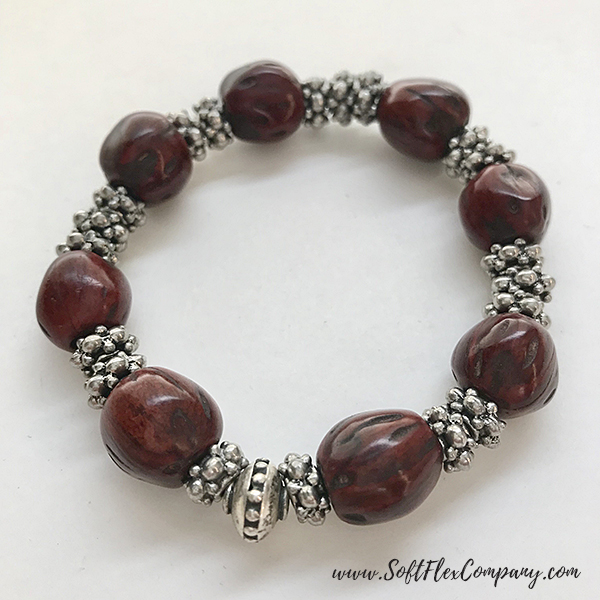
Memory Wire is perfect for a beginner, as long as you have the cutters to cleanly cut it. Memory Wire is a hard steel wire. Memory Wire comes packaged in coiled loops. The wire holds this shape. If you want to design a bracelet, simply cut the wire at the selected number of coils. Just remember, adding beads will make the design expand, three coils will look larger with beads added. Once you have added your beads, you can loop the end of the wire and add a dangle to finish. The finished design will slip over your wrist. You do not need a clasp to finish your Memory Wire design. So easy!
Note: Memory Wire is a very hard steel. Using flush cutters or bead nippers on Memory Wire will result in dulled or broken tools. Make sure you use the right tool for the right job. Make sure you use Memory Wire Cutters as they are specifically designed to cut through this wire.
Why does my necklace keep breaking?
"I really agree with your view that a piece is only as good as its parts!! As a painter and photographer, I use only the best. It may seem costly at first but even if I only sell two pieces I get that money back. I've been making jewelry since '96 and have made probably 250+ necklaces. I can count on one hand the number that have fallen apart and it was mainly from lack of knowledge re crimps. I only use Soft Flex Wire and when I can afford the 1000 ft roll I'll buy one." - Anne / Jewelry Artist
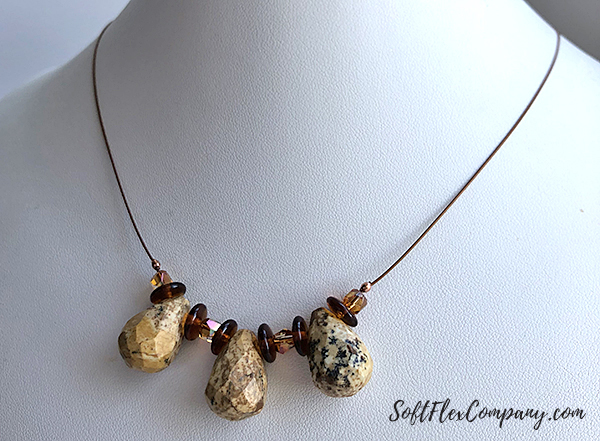
It is no fun having to restring or repair jewelry. Broken necklaces and bracelets can happen to the best of us. Fortunately, it is easy to diagnose the problem and respond accordingly. Think of yourself as a detective. What were you doing when the design broke? What did you string your necklace with? Did you use high quality crimps? Did you let the design breath?
Jewelry can break for many reasons. One blessing, or curse, is that it is often just a lack of user knowledge. Once you have become a seasoned jewelry designer, you will only have issues if your supplies are poor quality, invest in the highest quality materials and you will never have to worry about restringing.
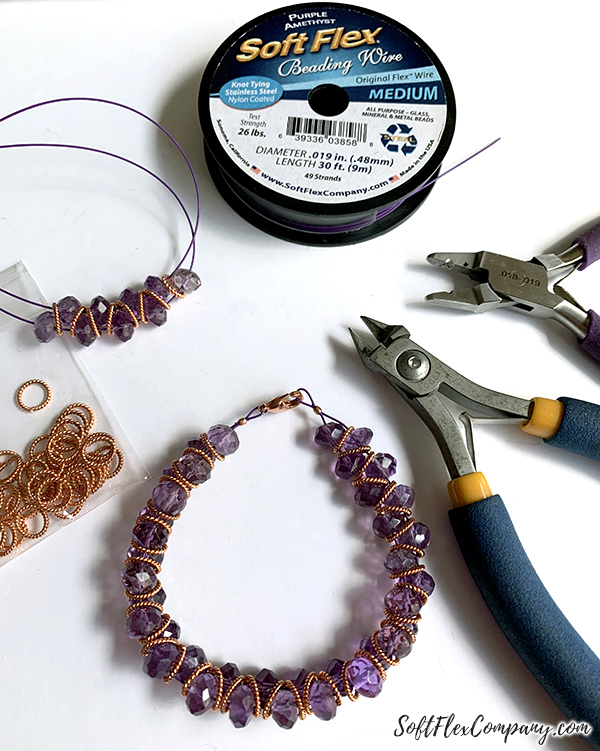
Reasons why your jewelry is breaking:
- You are not using an appropriate diameter. Using a finer wire to string anything other than the smallest beads is going to lead to a restring. Use the largest diameter that will fit through your beads once.
- Your beads have sharp edges inside their channels A bead reamer is a tool that corrects this. It smooths the inside of your beads out and can also enlarge the channel.
- You are not letting your designs breath. Leave room between the last bead and your crimps. If they are too close together, your designs is going to be taut and full of tension.
- Your wire is crossed inside your crimps. Make sure your wire is parallel inside the crimp or the crimp will slip and not be secure.
- Your crimp is slipping, but the wires are parallel. You need to make sure you brush up on your crimping techniques. We have lots of helpful videos and tips!
- You are crimping too hard. If you smash your crimps down with a lot of pressure, you are going to work harden the metal and make them brittle. Just apply as much pressure as you would shaking your grandmother's hand.
- You wire just snapped. If you are using the right diameter, you may be using a budget wire. Good on the wallet, maybe, but if that wire is poorly made, it is going to break.
- Your crimps have broken. Make sure you are using high quality crimps. Budget crimps might be made out of base metals. Soft metals, like gold filled or sterling silver, will conform around your wire and remain strong.
- You are not using the right tools. Don't smash your crimps with pliers. Use crimping pliers to ensure that the finished crimp will have a uniform shape and no irregular edges.
- Your tool is right, but the size is not. If you are crimping 3x3mm crimps, make sure you are using the right size crimping pliers. Mighty Crimping Pliers works, in this case.
- Your knot in your stretchy cord has failed. Make sure you have a good tight knot and then use a gap filling glue to bind the inside of the knot so it doesn't fail.
Now you have all of the information you need to correct any problems you have with breaking jewelry. Use the right tools and diameters for the job. Use high quality materials, you might pay more upfront, but you will never have to worry about your jewelry breaking, which saves money down the road. Master your crimping technique. You will be a premium jewelry designer in no time!
What are strands on beading wire? I saw there are 49-strand as well as 7-strand and so on. What's the difference?
There is a lot to take in when looking at a beading wire label. Strands are just one of the items. Strands refers to the number of wires that comprise a single strand of beading wire. Beading wire is not a solid cord of stainless steel. It is a collection of interwoven strands sheathed inside a nylon coating. These strands give the wire its flexibility, soft drape, and tenacious strength.
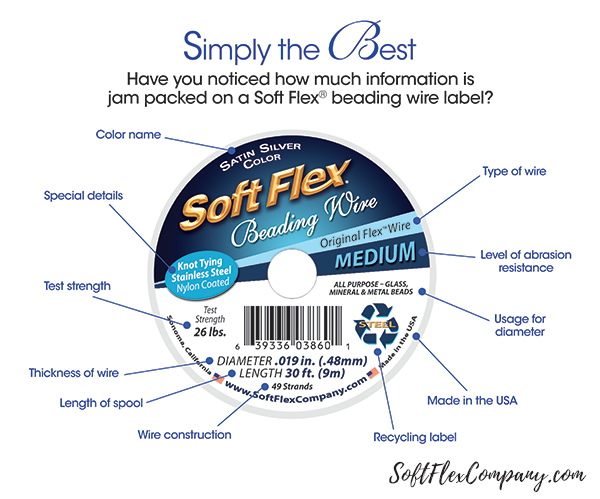
We do not rely on strands as a benchmark for quality at Soft Flex Company. As mentioned earlier, we think size (the largest wire that fits through your beads once) and diameter (the abrasion level of beads the wire can tackle) are better indicators of which wire you should use with a given project.
Strands can also be confusing when ordering Soft Flex Beading Wire. If you talk to us and ask for a 49 strand wire, you are going to have two options. Our Medium is a 49 strand wire. Our Heavy is a 49 strand wire. Medium is your best bet for most designs. Heavy is your go to for bracelets and really chunky, abrasive stone. Our Fine is a 21 strand wire, great for soft beads, like pearls and seed beads. Our Very Fine is comprised of only 7 strands, it is designed for the most delicate beading or using as a thread replacement for weaving, knitting, or embellishing.
Our Soft Flex Extreme is a 19 strand wire. Extreme beading wire is free of heavy metals and completely recyclable. It has a copper alloy base with 24k Gold, 925 Sterling Silver, and Champagne color plating. This is a high end wire for designers that want stunning and radiant jewelry.
Strands are one piece of the puzzle. Make sure you designs with size and diameter in mind.
What tools do I need to start beading?
You need very few tools to begin your favorite new hobby. Bead stringing is surprisingly accessible.
You are going to need a pair of Cutters, or beading nippers, to cut your wire. Don't try to use scissors, you are going to ruin your wire and your scissors. You can start with a pair of economy cutters as you will not be cutting a lot of material, just yet. Once you have started designing more and more jewelry, you will need a better pair of cutters. Professional cutters are constructed of much harder metal and will last years, compared to the soft metal blades of economy cutters.
You are going to need Crimping Pliers. Don't use regular pliers to smash your crimps. They will leave your crimps weak and with irregular surfaces. Crimping pliers will give you a secure and uniform professional finish. The most common crimps, 2x2mm, can be finished with regular or Magical Crimping Pliers. We have lots of information on our site and YouTube channel if you need some gentle instruction.
You are going to want to the best beading wire, unless you want to restring your designs. Soft Flex Beading Wire should be your first choice for jewelry that lasts. Make sure you select the correct size and diameter for your work. .019 Medium is a great selection for nearly every design.
Don't settle for budget crimps. Soft Flex Crimps are almost double the wall thickness of other crimps on the market. They are incredibly durable. They are also seamless. They do not have a weak point that can make them brittle and prone to slipping. Our crimps are made with soft metals. They are not base metal. They will conform around your wire when crimped and provide a secure finish.
Bead Stoppers are optional. But they are super handy. They allow you to secure your beads and wire in place before you crimp your design. They are useful if you want to work on one end of your jewelry and do not want the beads to slip. They are also fantastic if you have to put your unfinished piece down. Kitty cat is not going to be able to scatter your beads across the floor if you have a Bead Stopper guarding your work.
You will need a Clasp to finish your work. Clasps will open and close and allow you to easily put your jewelry on and take it off. Not all designs require a clasp, but having them on hand is a good idea.
Lastly, you are going to need Beads. Beautiful, sparkling, shiny beads. That is the whole reason you want to make jewelry, right? You love beads as much as we do. There are no rules here. Go with what your heart wants.
Shop our kits.
A Bead Stringing Starter Kit is the perfect kit for anyone to get started in beading and jewelry-making. This kit is exactly what you need to make your own DIY necklaces and bracelets.
This Bead Stringing Starter Kit includes a Bead Mat, 2 red tip Bead Stoppers, Regular Crimping Pliers, Bead Nipper, 20 count package of 2x2mm Crimp Tubes, Ear Wires, Lobster Clasps, a 10ft spool of Soft Flex .019 Medium Beading Wire in your choice of color and a FREE package of Beads. (Bead colors vary and will be based on your wire color choice).
We also have Design Kits full of enough beads and components to make lots of themed jewelry. Our Design Kits are limited inventory and sell out fast. Make sure you look for a new one at the end of each month. We are full of surprises and you are going to love these mystery kits.
I am a new beader. I like to make long seed bead necklaces and not add clasps. Does this tie good and tight without slipping?
We always suggest using crimps to finish your work for the most secure jewelry. A finished crimp can look great and it will withstand a lot of abuse. If you do not like the look of a finished crimp, you can always opt for crimp covers to conceal the crimps. You can also use Magical Crimping Pliers to turn a crimp tube into a decorative and rounded bead.
That said. You can knot our wire. If you tie a Figure 8 knot, you will have a pleasant looking knot with a solid finish. If you want even more security, you can dab the knot with a gap filling glue, we love Special T Glue. Special T dries within a minute. It dries pliable, not hard and crunchy and has a clear finish. Gap filling glues get into the nooks and crannies of the knots and look everything down.
Join our Facebook group – VIB. Stay in the know. Stay up to date. From our bead shows to our video shows and sales, you can stay in touch with us. The community is full of artistic and helpful beaders and crafty people. Inspire and be inspired. Share your pictures and get the beading bug from others!
Visit the
Soft Flex Company YouTube Channel!

Blog contributor Thomas Soles loves Jazz Age writers and crunchy french fries. His favorite gemstones are Lapis and Pietersite. His favorite hobby is day dreaming. And his favorite mustache is Freddie Mercury's. As you can see, he has a healthy (or possibly unhealthy) sense of humor. You can write to him at Thomas@SoftFlexCompany.com



